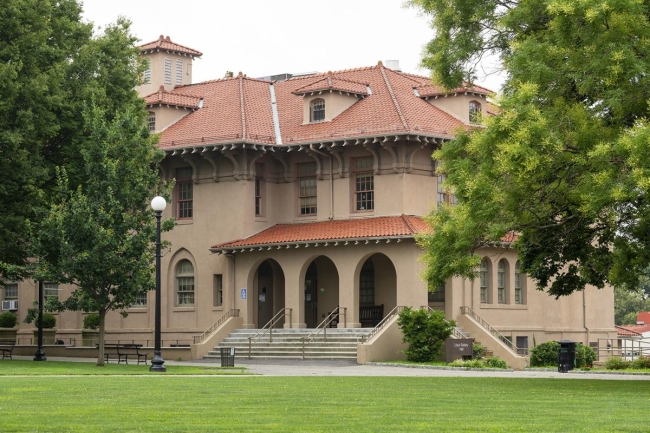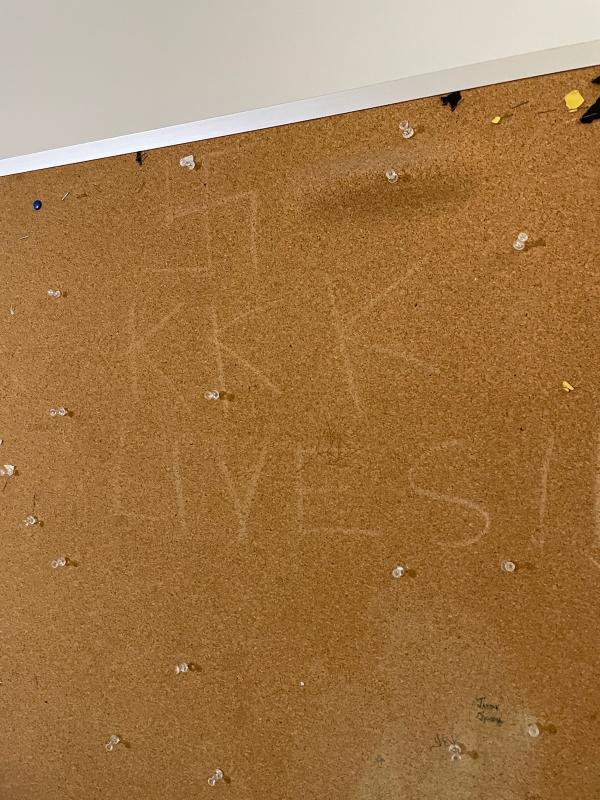You have /5 articles left.
Sign up for a free account or log in.

Delany Hall
Andy Poon
A months-long conflict has been simmering between a group of faculty and staff members of color and administrators at Queens College after a racist message was found written on a bulletin board on campus. Some professors, employees and students say campus leaders lagged in responding to their demands for new safety measures and mental health supports, which—even after some significant wins—left them feeling burned out and disheartened. Administrators say their response to the incident was thorough and immediate.
“The administration has openly expressed that it really is hoping that this will just go away and that we will stop pushing the issue,” said Natanya Duncan, director of Africana studies and an associate professor of history at Queens College. “They’re treating us like we’re a dog with a bone.”
 Duncan and her colleagues are still smarting from an incident when a staff member discovered “KKK Lives!” and a swastika carved into a corkboard at Delany Hall on Jan. 6, the one-year anniversary of the riot at the U.S. Capitol. Duncan also received an anonymous, threatening phone call on her cellphone later that month calling her a “bitch” and using a racial slur.
Duncan and her colleagues are still smarting from an incident when a staff member discovered “KKK Lives!” and a swastika carved into a corkboard at Delany Hall on Jan. 6, the one-year anniversary of the riot at the U.S. Capitol. Duncan also received an anonymous, threatening phone call on her cellphone later that month calling her a “bitch” and using a racial slur.
Delany Hall, named for a Black former psychology professor, houses the college’s Africana studies program; the Center for Ethnic, Racial and Religious Understanding; and a scholarship and academic support program created to recruit and retain low-income students of color called the Search for Education, Elevation and Knowledge (SEEK) program. Lloyd Delany, the building’s namesake, was the SEEK program’s first Black director.
Duncan described Delany Hall as the “safe haven for marginalized groups” on the City University of New York campus.
“This situation has required prioritized focus and continued attention,” Jerima DeWese, chief diversity officer and dean of diversity at Queens College, said of the vandalism incident via email. “The fact that there are continuing and transparent discussions between the administration and colleagues in Delany Hall is indicative of the Queens College administration’s receptiveness to hearing concerns and suggestions for improvements.”
The incident made Duncan and other employees working in Delany feel unsafe and worried about the safety of students scheduled to return to campus later that month for the start of the spring semester.
Sophia McGee, the former founding director of the college’s Center for Ethnic, Racial and Religious Understanding, said campus leaders seemed not to fully understand the depth of concern among faculty and staff members who work in Delany Hall. She now serves as director of intercultural student engagement and dialogue for the CUNY system.
She pointed out that violent attacks, such as the recent shootings that targeted Black people in a Buffalo, N.Y., supermarket, often come after racist remarks and screeds.
“I think what has gotten lost in this whole thing is the entire context of how this happened and where we kind of are as a country, with rising rates of not only hate speech but actual actions, very violent actions,” she said. “There seems to be kind of a shorter distance between hate speech and actual incitement at this point than there has been at other times in history. We actually felt like it was a direct threat.”
Queens College president Frank H. Wu responded to the hateful message in an email sent campuswide on Jan. 7 notifying the campus of the incident and stating that the college stands “strongly against racism, sexism, bigotry, and religious intolerance of any kind.”
A statement from DeWese followed a few days later that confirmed campus public safety officers had begun an investigation. She also reached out to the staff member who first saw the vandalism and some program leaders in Delany Hall to meet about the incident.
“These symbols and markings impose harm upon people who are understandably upset and deserve our strong support,” she said.
A series of meetings and back-and-forth email messages between faculty members and college administrators ensued. Duncan and the directors of two other programs in the building, along with other colleagues, emailed a letter to Wu and DeWese on Jan. 11 calling for “specifics on protective measures to be implemented for Delany Hall’s residents and premises.” The faculty and staff union at CUNY, the Professional Staff Congress, also known as PSC-CUNY, threw its support behind the group of employees and also urged more action from administrators on their behalf in a letter in January.
A Zoom meeting between Wu and Delany Hall faculty and staff members on Jan. 13 again left the group dissatisfied.
Administrators provided no information about “what’s the protocol going to be, what safety measures are going to be added to the building, what is the investigation process,” said Norka Blackman-Richards, director of the SEEK program.
Subsequent public statements from campus leaders gave assurances that the Office of Public Safety had alerted community affairs officers at the New York Police Department of the incident. But Duncan said a call to the NYPD, followed by a visit to the nearby precinct in mid-February, revealed no formal report had been filed by the college. DeWese said in an email that the chief of public safety “verbally reported the hateful scrawls” to the NYPD a few days after the graffiti was discovered but filed a more formal report with the NYPD later in February.
Jarred by the missing police report, and unsatisfied with the college’s progress on providing additional security for the building, the group of Delany faculty and staff sent campus leaders a list of requests on Feb. 22. They asked administrators to bring in “a skilled BIPOC facilitator in racial trauma” to help students and staff members process the incident as a group, to publicize a clear timeline for the investigation and putting in place safety patrols of parking lots around the building, and to install panic buttons and a key-card access system, among other safety measures. The letter also highlighted infrastructure problems with the building. Duncan described the stairs as “crumbling” so badly two students had slipped on them and been injured.
Administrators toured Delany Hall in March. The Office of Compliance and Diversity also held an event as part of a speaker series in April, featuring a conversation between Wu and Myrlie Evers-Williams, the widow of slain civil rights leader Medgar Evers, followed by two breakout discussions, one focused on the vandalism incident at Delany Hall. But people working in Delany Hall weren’t consulted in the planning of the event and many couldn’t attend, so only a handful came to the discussion, Duncan said.
“How are you having a meeting or an event centered on a crisis that affects us without involving us, without engaging us?” Duncan said.
In the meantime, some students were afraid after the graffiti incident. Braneyda Pierre, a freshman in the SEEK program, said she felt unsafe when she came back to campus and another student told her about the vandalism.
“I don’t feel like I’m in a safe environment anymore,” she said. “I’m supposed to come to school and feel at peace and be happy around the people I’m around. I think it’s supposed to give me like a community feeling, where I feel like I’m safe and I’m wanted. It hurts.”
Delany Hall faculty and staff members have since had many of their demands met. Campus security increased public safety patrols in and around the building and installed cameras around the perimeter. A security guard was stationed in front of the building starting in early March, and a key-card entry system is in the process of being put in place, DeWese said. The lighting in and around the building has been upgraded recently, and the president plans to prioritize Delany for infrastructure assessments and updates, she said. Faculty and staff members are now being interviewed as part of the investigation of the incident, and Wu held a Zoom meeting last week with students, faculty, staff and union members concerned about the vandalism incident.
DeWese emphasized that addressing faculty and staff members’ concerns has been a priority for the administration.
“Queens College expressly rejects racism, antisemitism and bigotry of any kind on our campus,” she said. “The hateful markings on the bulletin board in Delany Hall were racist and antisemitic and are a clear and direct violation of our community and campus values. No one has the right to invoke fear and angst in our community members or vandalize and defile our buildings.”
She noted that the campus is the first in the CUNY system to hire someone with the title of chief diversity officer and dean of diversity. The college also has public safety officers undergoing antibias training, and the current administration established three working groups of students, faculty and staff members from diverse backgrounds to confront issues of diversity, equity and inclusion at the college.
Charles H. F. Davis, an assistant professor of higher education at the University of Michigan who has worked on campus climate assessments for more than a decade, said it’s common for students and faculty members affected by racist incidents to feel like campus leaders aren’t responding fast enough.
“Institutional bureaucracy, at its best and at its worst, always takes more time than people who have been harmed can afford,” he said.
He noted colleges and universities also often lack clear protocol for how to respond to racist incidents, which can slow down the response process.
“The minimal first step is determining what the protocol of action is going to be and that being deferential to what needs have been expressed,” he said. He emphasized that “administrators have to listen when people tell them what’s going on and defer to them as experts of their own experiences.”
They also need to strike a “delicate balance” to ensure the people harmed aren’t overburdened by having to implement all the solutions themselves, he added.
Blackman-Richards believes the drawn-out process has soured morale among staff in Delany, but she left the meeting between administrators and faculty and staff last week feeling like everyone had engaged in “respectful” dialogue.
“I am hopeful that this may open their eyes to the reality of what is needed for the campus to function with equity and what does it really mean to include all voices,” she said.
Others aren’t feeling as optimistic. Pierre, the student in the SEEK program, attended the meeting with the president but left still feeling unheard.
“I personally felt like we were just going around in circles,” she said. “I don’t feel like anything students asked, he really responded to. He was just there to answer questions and go about his day. I don’t know what I was hoping for. I just feel like I needed some closure. I just wanted to know that somebody was there with us and understood that we were going through something.”





